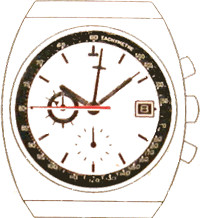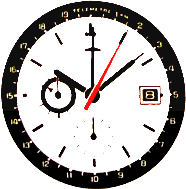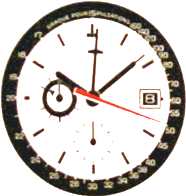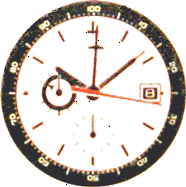|
View
of the Bezel
|
Bezel
Type/Description/Example of
Use:
|
|
Tachymetre
(Tachoproductometric)
|

|
- Description:
Allows one to compute speeds and machine
outputs.
-
- Examples
of Use:
- 1)
To calculate the speed of a car over a known
distance press the top chronograph button
when entering the fixed distance press it
again when at the end of the fixed distance.
If the time elapsed is 45 seconds the second
hand points to the figure 80 on the Tachy
scale. If the fixed distance is a Kilometer
then the car is traveling 80 kilometers per
hour. If the distance covered is a mile, then
the speed is indicated in Miles per hour, in
this example 80 MPH...
-
- 2)
To calculate the output of a machine,
start the chronograph and count a set number
of units made, at the end of this number stop
the chronograph. If you counted to 100 and
the second hand points to 75 on the Tachy
ring, the machine's hourly output is 75 times
100 or 7,500 units per
hour.
|
|
Telemetric
(offered in both
kilometers/miles)
|

|
Description:
The Telemetric scale is graduated to
indicate the speed of sound in air. This allows
the user to calculate the distance between the
observer and a situation that is observable both
visually and audibly.
- Description
of Operation:
- On an
optical signal, start the chronograph. When
you hear the sound stop the chronograph. The
number indicated at the distance in
kilometers or miles (depending on
scale).
-
- Examples
of Use:
- At
the flash of a bolt of lightning start the
chronograph. Stopping the chronograph when
you hear the thunder (in the case of the
diagram at left at 5 Seconds) will indicate
on the Telemetre ring 1.6km or 1600 meters
away from the wearer of the watch. Sounds
like a good time to take cover!
=)
-
|
|
|
Pulsimetric
|

|
Description:
The Pulsimetric scale is graduated to
indicate the rate of respiration or pulse of a
patient. This allows the user to take a pulse or
observe a certain number of respirations and
read off the correct number of respiration/pulse
per minute.
- Description
of Operation:
- The
top chronograph button is pressed at the
beginning of a pulse or respiration, it is
pressed again when the proper number of
pulsations/respirations has occurred. The
proper number of pulsations is indicated
on the bezel dial.
-
- Examples
of Use:
- At
the start of a pulsation the operator starts
the chronograph, after the 15th pulse the
operator stops the chronograph at 18 seconds.
Reading from the stopped second hand to the
Pulsimetric scale results in a pulse rate of
50 beats per minute for this
patient.
-
|
|
|
Decimal
|

|
Description:
For industrial timing, statistical analysis,
calculation of averages and cost prices the use
of decimal division of time is
common.
- Description
of Operation:
- To
measure the length of time it takes to
perform any operation start the chronograph
when work begins and stop it when the work on
the second piece begins. This results in the
amount of time to produce a
piece.
-
- Examples
of Use:
- If a
worker is fitting a bracelet to a watch, an
observer starts the chronograph when the
worker begins on a unit to be assembled and
stops it when the worker begins on the second
unit. The time read off the bezel indicates
the time this operation took in hundredths of
a minute, in the diagram at left 0.28 minutes
per piece.
-
|
-
Statement
of rights retained and permissions
granted...
-
- Sources
included my own research, images gleaned from
various sources on the web, Omega Designs
book, the Time Capsule book and other Omega
Publications and web sites.
-
- The scans are
adapted and modified from pictures in the
original owners manual for the Omega
Speedmaster 125. Special thanks to Simon
Debrux for his contributions to this
article.
-
- Permission is
granted for Damon, RJ, Derek and/or Frank N.
to include within the FAQ's they are writing
as long as I and the others mentioned in this
section and the section above are given
credit for their contributions. Permission
for personal, educational or non-commercial
use is granted. The author retains all other
rights not specifically mentioned
here.
-
- For all other
use please contact
the author.
-
- Disclaimer:
Opinions are my own and knowing me should be
taken with a grain or two of salt...
|
I hope
you find this informational and
entertaining. Please contact me if
you have corrections,
|
|
additions
or other comments.
--
Chuck
(cmaddox@xnet.com)
|
|

|
|